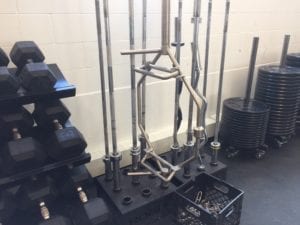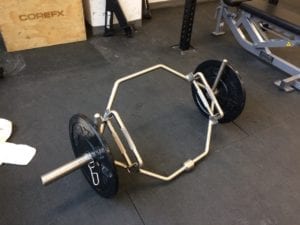I much appreciate learning about the work of Stuart McGill (“Dr. Spine”) of Waterloo
I owe many thanks to Jacqueline Marie Murdoch of Toronto for her reference, some time back, to the work of Stuart McGill of Waterloo.
Several books by Stuart McGill are available at the Toronto Public Library. As well, several YouTube videos are available online, in which McGill clearly and cogently outlines topics of interest, such as the necessity of maintaining a neutral alignment of the spine, when a person is doing a wide range of movements.

Sometimes the hex bar, which weights 60 lbs, gets stored on a barbell rack at the Humber Fitness Centre; at other times it’s stored along a wall or on the floor. Jaan Pill photo
In particular, in recent months I’ve been learning to perform the deadlift using a hex bar, at the Humber Fitness Centre in Long Branch where I work out. I currently perform a series of reps once a week, to ensure enough time for recovery. In time I may move to lifting with the hex bar twice a week.
If you perform the deadlift correctly, you get stronger. Perform it wrong, and you wreck your back.
After much practice, I’ve got the “hip-hinge” move worked out quite well, and make a point of following instructions to hold my breath (that is, to engage in “blocking”) and to keep my back, abdomen, and lats under tension as I start the deadlift.

When correctly performed (correct form being essential), the hex-bar deadlift enables a person to follow a more straightforward (thus less taxing on the body) “line of power” movement pathway than is available with a conventional deadlift. That said, the (correctly performed) barbell-deadlift is a highly valuable exercise as well. Jaan Pill photo
I’ve been wondering exactly what the details are, in terms of the physical forces acting on the spine, that are at play when holding one’s breath during such a lift.
Lots of information about such topics is available online.
It’s not always easy, however, to determine what is evidence-based, and what is just conjecture, in this area as in many others.
With Stuart McGill, the research evidence is robust, and it’s clearly presented. I am delighted to be getting acquainted with his work.


Leave a Reply
Want to join the discussion?Feel free to contribute!